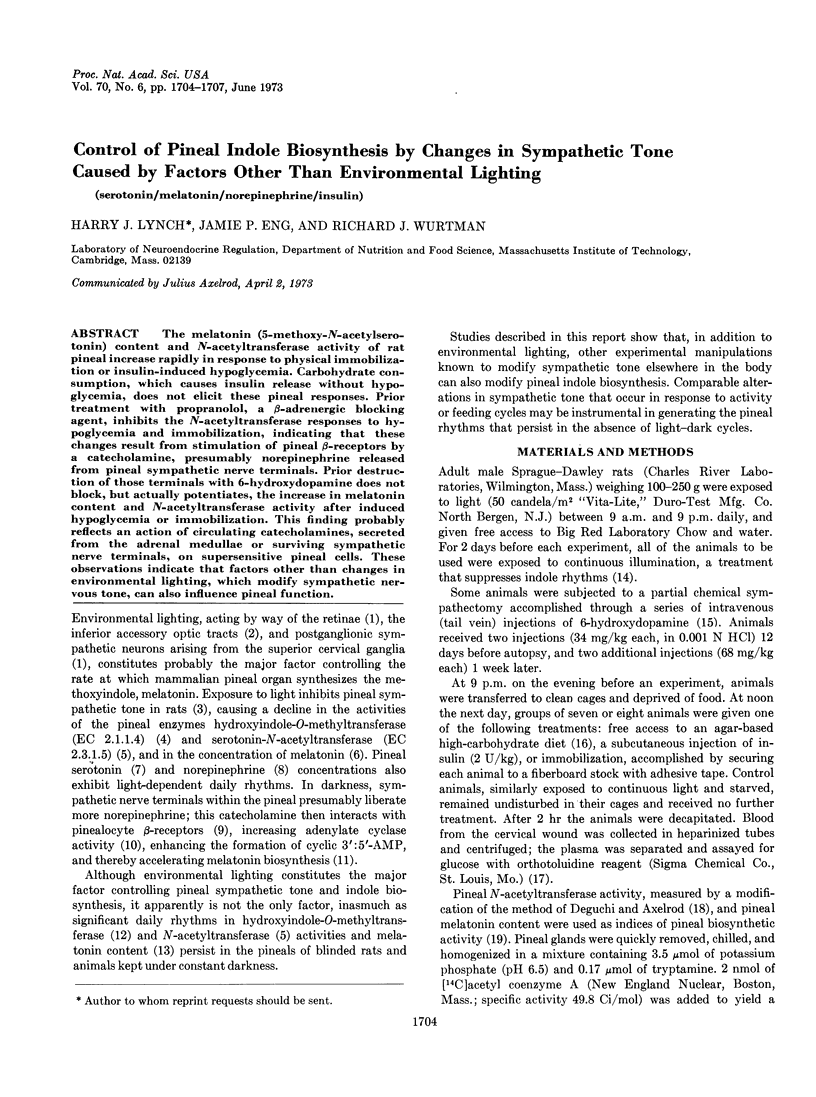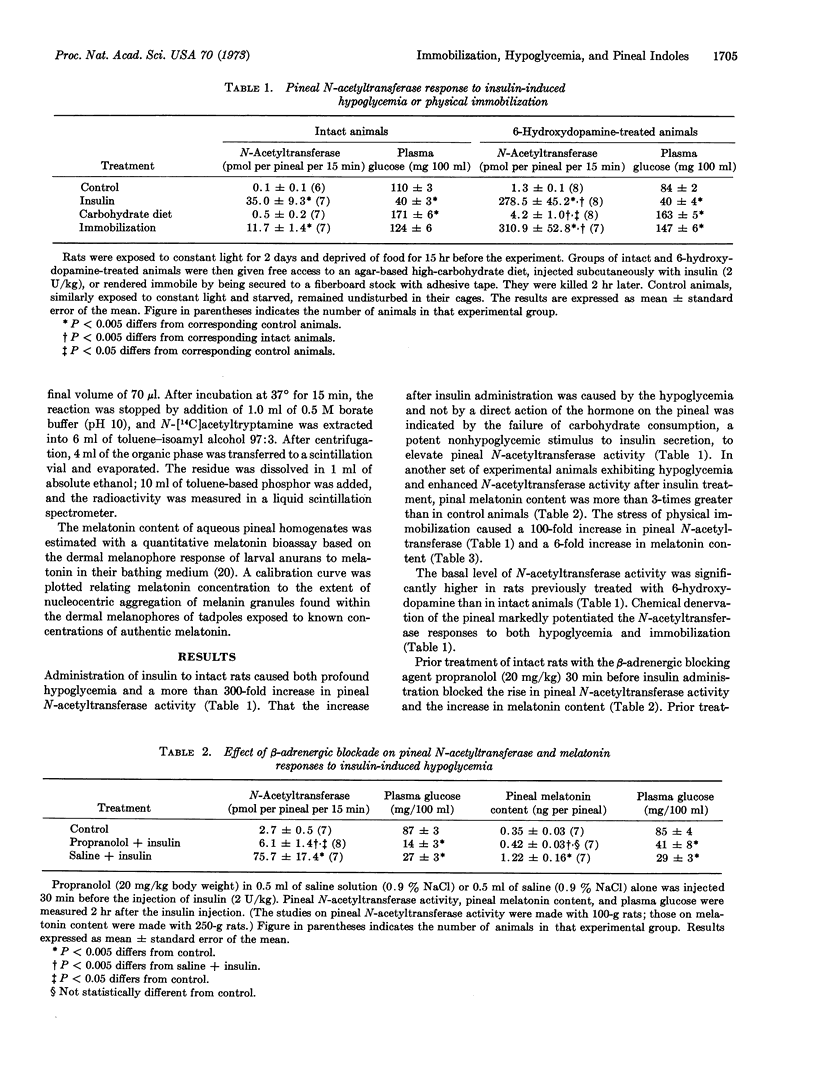Abstract
The melatonin (5-methoxy-N-acetylserotonin) content and N-acetyltransferase activity of rat pineal increase rapidly in response to physical immobilization or insulin-induced hypoglycemia. Carbohydrate consumption, which causes insulin release without hypoglycemia, does not elicit these pineal responses. Prior treatment with propranolol, a β-adrenergic blocking agent, inhibits the N-acetyltransferase responses to hypoglycemia and immobilization, indicating that these changes result from stimulation of pineal β-receptors by a catecholamine, presumably norepinephrine released from pineal sympathetic nerve terminals. Prior destruction of those terminals with 6-hydroxydopamine does not block, but actually potentiates, the increase in melatonin content and N-acetyltransferase activity after induced hypoglycemia or immobilization. This finding probably reflects an action of circulating catecholamines, secreted from the adrenal medullae or surviving sympathetic nerve terminals, on supersensitive pineal cells. These observations indicate that factors other than changes in environmental lighting, which modify sympathetic nervous tone, can also influence pineal function.
Keywords: serotonin, melatonin, norepinephrine, insulin
Full text
PDF



Selected References
These references are in PubMed. This may not be the complete list of references from this article.
- Axelrod J., Wurtman R. J. Photic and neural control of indoleamine metabolism in the rat pineal gland. Adv Pharmacol. 1968;6(Pt A):157–166. doi: 10.1016/s1054-3589(08)61169-2. [DOI] [PubMed] [Google Scholar]
- Berkowitz B. A., Spector S., Tarver J. H. Resistance of noradrenaline in blood vessels to depletion by 6-hydroxydopamine or immunosympathectomy. Br J Pharmacol. 1972 Jan;44(1):10–16. doi: 10.1111/j.1476-5381.1972.tb07233.x. [DOI] [PMC free article] [PubMed] [Google Scholar]
- Deguchi T., Axelrod J. Induction and superinduction of serotonin N-acetyltransferase by adrenergic drugs and denervation in rat pineal organ. Proc Natl Acad Sci U S A. 1972 Aug;69(8):2208–2211. doi: 10.1073/pnas.69.8.2208. [DOI] [PMC free article] [PubMed] [Google Scholar]
- Deguchi T., Axelrod J. Sensitive assay for serotonin N-acetyltransferase activity in rat pineal. Anal Biochem. 1972 Nov;50(1):174–179. doi: 10.1016/0003-2697(72)90496-4. [DOI] [PubMed] [Google Scholar]
- Eränkö O., Eränkö L. Loss of histochemically demonstrable catecholamines and acetylcholinesterase from sympathetic nerve fibres of the pineal body of the rat after chemical sympathectomy with 6-hydroxydopamine. Histochem J. 1971 Sep;3(5):357–363. doi: 10.1007/BF01005017. [DOI] [PubMed] [Google Scholar]
- Fernstrom J. D., Wurtmen R. J. Elevation of plasma tryptophan by insulin in rat. Metabolism. 1972 Apr;21(4):337–342. doi: 10.1016/0026-0495(72)90078-9. [DOI] [PubMed] [Google Scholar]
- Klein D. C., Weller J. L. Indole metabolism in the pineal gland: a circadian rhythm in N-acetyltransferase. Science. 1970 Sep 11;169(3950):1093–1095. doi: 10.1126/science.169.3950.1093. [DOI] [PubMed] [Google Scholar]
- Lynch H. J. Diurnal oscillations in pineal melatonin content. Life Sci I. 1971 Jul 15;10(14):791–795. doi: 10.1016/0024-3205(71)90033-6. [DOI] [PubMed] [Google Scholar]
- Moore R. Y., Heller A., Bhatnager R. K., Wurtman R. J., Axelrod J. Central control of the pineal gland: visual pathways. Arch Neurol. 1968 Feb;18(2):208–218. doi: 10.1001/archneur.1968.00470320110013. [DOI] [PubMed] [Google Scholar]
- Mueller R. A., Thoenen H., Axelrod J. Adrenal tyrosine hydroxylase: compensatory increase in activity after chemical sympathectomy. Science. 1969 Jan 31;163(3866):468–469. doi: 10.1126/science.163.3866.468. [DOI] [PubMed] [Google Scholar]
- Nagle C. A., Cardinali D. P., Rosner J. M. Light regulation of rat retinal hydroxyindole-O-methyl transferase (HIOMT) activity. Endocrinology. 1972 Aug;91(2):423–426. doi: 10.1210/endo-91-2-423. [DOI] [PubMed] [Google Scholar]
- QUAY W. B. CIRCADIAN RHYTHM IN RAT PINEAL SEROTONIN AND ITS MODIFICATIONS BY ESTROUS CYCLE AND PHOTOPERIOD. Gen Comp Endocrinol. 1963 Oct;3:473–479. doi: 10.1016/0016-6480(63)90079-0. [DOI] [PubMed] [Google Scholar]
- Ralph C. L., Lynch H. J. A quantitative melatonin bioassay. Gen Comp Endocrinol. 1970 Oct;15(2):334–338. doi: 10.1016/0016-6480(70)90083-3. [DOI] [PubMed] [Google Scholar]
- Ralph C. L., Mull D., Lynch H. J., Hedlund L. A melatonin rhythm persists in rat pineals in darkness. Endocrinology. 1971 Dec;89(6):1361–1366. doi: 10.1210/endo-89-6-1361. [DOI] [PubMed] [Google Scholar]
- Shein H. M., Wurtman R. J. Cyclic adenosine monophosphate: stimulation of melatonin and serotonin synthesis in cultured rat pineals. Science. 1969 Oct 24;166(3904):519–520. doi: 10.1126/science.166.3904.519. [DOI] [PubMed] [Google Scholar]
- Taylor A. N., Wilson R. W. Electrophysiological evidence for the action of light on the pineal gland in the rat. Experientia. 1970 Mar 15;26(3):267–269. doi: 10.1007/BF01900087. [DOI] [PubMed] [Google Scholar]
- Thoenen H., Tranzer J. P. Chemical sympathectomy by selective destruction of adrenergic nerve endings with 6-Hydroxydopamine. Naunyn Schmiedebergs Arch Exp Pathol Pharmakol. 1968;261(3):271–288. doi: 10.1007/BF00536990. [DOI] [PubMed] [Google Scholar]
- WURTMAN R. J., AXELROD J., FISCHER J. E. MELATONIN SYNTHESIS IN THE PINEAL GLAND: EFFECT OF LIGHT MEDIATED BY THE SYMPATHETIC NERVOUS SYSTEM. Science. 1964 Mar 20;143(3612):1328–1330. [PubMed] [Google Scholar]
- WURTMAN R. J., AXELROD J., PHILLIPS L. S. MELATONIN SYNTHESIS IN THE PINEAL GLAND: CONTROL BY LIGHT. Science. 1963 Nov 22;142(3595):1071–1073. doi: 10.1126/science.142.3595.1071. [DOI] [PubMed] [Google Scholar]
- Weiss B., Costa E. Adenyl cyclase activity in rat pineal gland: effects of chronic denervation and norepinephrine. Science. 1967 Jun 30;156(3783):1750–1752. doi: 10.1126/science.156.3783.1750. [DOI] [PubMed] [Google Scholar]
- Wurtman R. J., Axelrod J., Sedvall G., Moore R. Y. Photic and neural control of the 24-hour norepinephrine rhythm in the rat pineal gland. J Pharmacol Exp Ther. 1967 Sep;157(3):487–492. [PubMed] [Google Scholar]
- Wurtman R. J., Shein H. M., Larin F. Mediation by -adrenergic receptors of effect of norepinephrine on pineal synthesis of ( 14 C)serotonin and ( 14 C)melatonin. J Neurochem. 1971 Sep;18(9):1683–1687. doi: 10.1111/j.1471-4159.1971.tb03741.x. [DOI] [PubMed] [Google Scholar]


